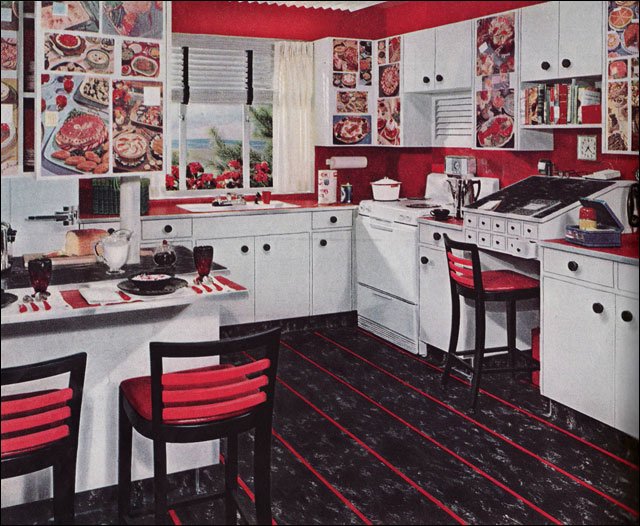Американские кухни 1950х.
Jun. 15th, 2021 06:51 am1950-е годы. Война закончилась, и Соединенные Штаты вступают в эпоху беспрецедентного процветания.
Миллионы солдат вернулись домой, стремясь к комфорту, которого им так не хватало.
Все стали обустраивать свои гнезда.
В новых пригородах строилось рекордное количество домов.
Центром их всех была кухня.
Миллионы солдат вернулись домой, стремясь к комфорту, которого им так не хватало.
Все стали обустраивать свои гнезда.
В новых пригородах строилось рекордное количество домов.
Центром их всех была кухня.
Новая, современная американская кухня приняла форму, которая была создана в Баухаусе еще в 1920-х годах - встроенные шкафы, длинная, непрерывная столешница над ними и встроенная в шкафы техника. Люди, которые не могли позволить себе купить новый дом или заменить кухню за один раз, были вынуждены модернизировать свою кухню понемногу, заменяя старые разрозненные кухни новыми современными шкафами - начиная с мойки. К 1940-м годам холодильники стали обычным явлением на американских кухнях. Дизайнеры бытовой техники в 1950-х годах экспериментировали с некоторыми конструкциями холодильников, которые сейчас могут показаться нам довольно необычными, например, настенный вариант 1952 года от GE, который заменял собой секцию верхних шкафов. Розовый агрегат под грандиозным названием "GE Refrigeration Center" объединял в себе настенный холодильник с выдвижными ящиками для холодильника (или морозильника), которые подходили к остальным шкафам.
Стальные кухонные шкафы были очень распространены в 1950-х годах, поскольку производители искали способы перепрофилировать сталелитейные заводы, производившие оружие для войны, на более бытовые нужды. Было довольно много различных производителей, включая GE, которые выпускали как бытовую технику, так и шкафы. GE также производила "шкафы", которые вы видите выше, - маленькие металлические шкафчики, предназначенные для установки под верхним шкафом (или на задней стенке).
На протяжении 1950-х годов дизайнеры и домовладельцы использовали цвет на кухне, хотя эти цвета были более мягкими, чем те, которые обычно встречались на кухнях 1930-х и 1940-х годов. Если в кухнях 1930-1940-х годов часто использовались более смелые цвета, такие как черный, красный или зеленый, то в 1950-х годах преобладали мягкие оттенки голубого, розового и желтого - шкафы конфетного цвета и соответствующая техника.
 |
| 1951 Western Style Youngstown Kitchen |
 |
1951 Armstrong Picture Kitchen |
 |
1951 Early American Kitchen |
 |
1953 Armstrong Kitchen |
 |
| 1953 Brown & Green Kitchen |
 |
1953 St. Charles Steel Kitchen |
 |
| 1954 Armstrong Suessian Kitchen – At least one viewer thought this kitchen was straight out of a Dr. Seuss book. We won’t argue; the color and odd angles on the divider make it distinctive. |
 |
| 1954 Duco Paint Ad Kitchen – The scallops and wrought iron hinges give this little kitchen some Early American flavor. |
Apartment Therapy)











